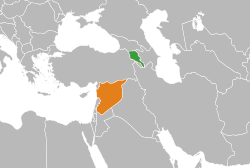 | |
Armenia |
Syria |
|---|---|
Armenian–Syrian relations are foreign relations between Armenia and Syria. Armenia has an embassy in Damascus and a consulate general in Aleppo. In 1997, Syria opened an embassy in Yerevan. Syrian Foreign Minister Farouk al-Sharaa visited Armenia in March 1992.
Country comparison
| Populations | 2,963,900 (2021 est.) | 18,604,031 (2021 est.) |
| Area | 29,743 km2 (11,484 sq mi) | 185,180 km (71,500 sq mi) |
| Population density | 101.5/km2 (262.9/sq mi) | 118.3/km2 (306.4/sq mi) |
| Capital | Yerevan | Damascus |
| Largest city | Yerevan | Damascus |
| Government | Unitary parliamentary republic | Unitary dominant-party semi-presidential republic |
| Current leader | President Vahagn Khachaturyan Prime Minister Nikol Pashinyan |
President Bashar al-Assad Prime Minister Hussein Arnous |
| Official languages | Armenian | Arabic |
| Main religions | 94.8% Christianity, 4% Not Religious, 0.8% Yazidism, 0.4% Other | 87% Islam, 10% Christianity, 3% Druzism |
History
On 6 March 1992, Syria established diplomatic relations with Armenia, soon after the collapse of the Soviet Union. Syrian President Hafez al-Assad maintained good relationships in part because of the large Armenian community in Syria.
Syrian Civil War

Despite the country's ongoing Syrian Civil War, the Armenian embassy is still open in Damascus and the countries maintain diplomatic relations.
Following president Bashar al-Assad's victory in the 2014 Syrian presidential election, Armenian president Serzh Sargsyan congratulated Assad, saying, "I wish you Bashar al-Assad good health and successes and I wish the friendly Syrian people eternal peace."
Armenia has also provided humanitarian aid to Syria throughout the civil war, most notably sending 40 tons of humanitarian aid including relief and food items in 2017. Armenian Ambassador Arshak Poladian stated that the aid “came under the directives of the President of Armenia and presented by the Armenian people.”
In 2022, the new Syrian Ambassador to Yerevan, Nora Asrinian, a Syrian Armenian and former MP of the People's Assembly of Syria, was appointed. This step was perceived by both parties as a further development of mutual relations.
On 23 February 2023, Armenian Foreign Minister Ararat Mirzoyan arrived in Damascus, where he met with his counterpart Faisal Mekdad and President Bashar al-Assad.
Armenian genocide and Nagorno-Karabakh conflict
Syria recognized the Armenian genocide in 2015, becoming the second Arab state after Lebanon to do so, which was perceived positively by Armenia and Armenians. This came amidst the straining of relations between Syria and Turkey. The Turkish Government was angered over the recognition. Armenia is accused by both Turkey and Azerbaijan of allowing Syrian refugees to resettle in Karabakh, amidst diplomatic tensions between Turkey and Syria. On 13 February 2020, the People's Assembly of Syria unanimously adopted a resolution recognizing and condemning the Armenian genocide.
In 2020, when the 2020 Nagorno-Karabakh conflict erupted, Syrian president Bashar al-Assad voiced his support for Armenia, accusing Turkey of sending terrorists into the region.
Cultural relations
Around 120,000 people of Armenian descent live in Syria. They compose a majority in the towns of Kessab and Yakubiyah, and play a part in the political life of Syria. During the Armenian genocide, the Ottoman Empire used the Syrian desert of Deir ez-Zor as the main killing fields of Armenians. The native Arabs sheltered and supported the Armenians.
A memorial complex commemorating this tragedy was opened in the city of Deir ez-Zor. It was designed by Sarkis Balmanoukian and was officially inaugurated in 1990 with the presence of the Armenian Catholicos of the Great House of Cilicia Karekin I. The complex contains bones and remnants recovered from the Deir ez-Zor desert of Armenian victims of the genocide and has become a pilgrim destination for many Armenians in remembrance of their dead, before being partially destroyed by ISIL.
See also
References
- Zisser 1995, p. 733.
- "Statistics". Retrieved July 2, 2021.
- "Population, total – Syrian Arab Republic". worldpopulationreview.com. World population review. Retrieved 1 January 2022.
- "President Sargsyan congratulates Syria's Assad on re-election". 13 June 2014.
- "Armenia sends 40 tons of humanitarian aid to Syrian people -Syrian Arab News Agency". Syrian Arab News Agency. 9 June 2017.
- ^ Mazen Eyon (15 June 2022). "President of Armenia receives credentials of Ambassador Asrinian; relations with Syria strong". Syrian Arab News Agency.
- "Mirzoyan and Bashar al-Assad discuss the work of overcoming the problems in the disaster-affected regions of Syria". 23 February 2023.
- Sassounian, Harut (January 29, 2014). "Sassounian: Syrian President Finally Recognizes Armenian Genocide". Armenian Weekly. Retrieved April 23, 2015.
- "Syria Armenians move to Nagorno-Karabakh: Azerbaijan - World News". 2 October 2013.
- "Syrian Parliament recognizes Armenian Genocide". Armenpress. 13 February 2020. Archived from the original on 26 April 2022.
- "Assad accuses Turkey of instigating Nagorno-Karabakh conflict - Al-Monitor: The Pulse of the Middle East".
- "Monument and Memorial Complex at Der Zor, Syria". Retrieved 4 December 2014.
- "IS said to destroy Armenian Genocide memorial". The Times of Israel. 22 September 2014. Retrieved 22 November 2019.
Bibliography
- Zisser, Eyal (1995). Ayalon, Ami (ed.). Middle East Contemporary Survey. Vol. 16. The Moshe Dayan Center. ISBN 9780813321332.
External links
| |||||||||||||||||
| |||||||||||||||||
| |||||||||||||||||
| Foreign relations of Syria | |
|---|---|
| Africa | |
| Americas | |
| Asia | |
| Europe | |
| Disputes | |
| Diplomatic missions | |
| Multilateral | |